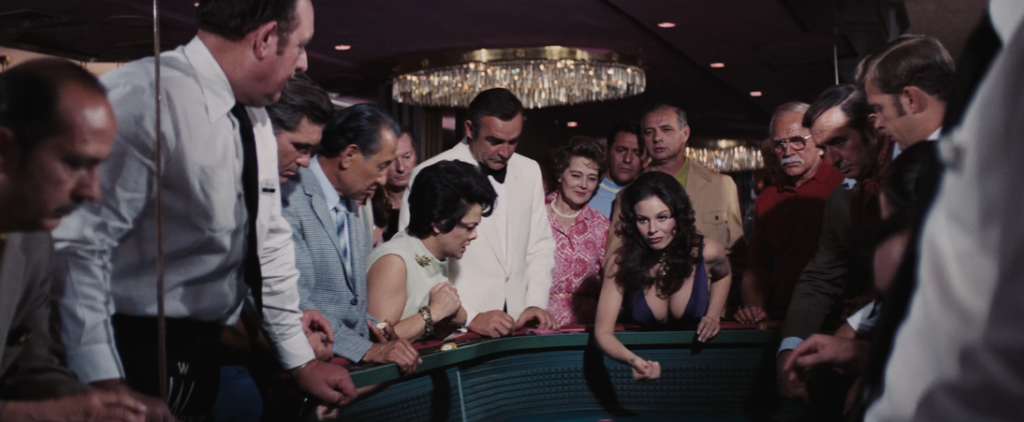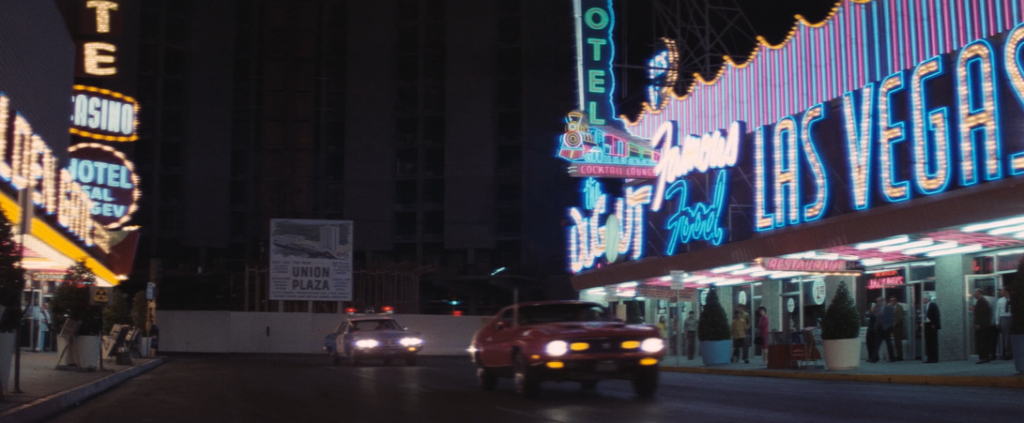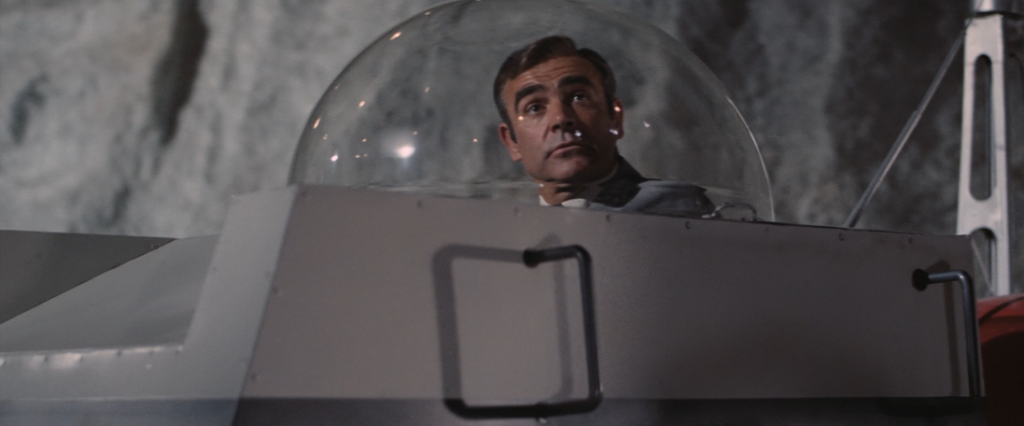This is the seventh essay in a 23-part series about the James Bond cinemas. I encourage everyone to comment on Diamonds Are Forever and join in on an extended conversation about not only the films themselves, but cinematic trends, political and other external influences on the series’ tone and direction.
Of [In]human #Bond_age_ #7: Remaking Diamonds Are Forever
by James David Patrick
With the power of distance and hindsight, how easy is it to criticize George Lazenby for breaking his seven-picture James Bond contract because he didn’t believe 007 would translate to the progressive 1970s? Roger Moore needed a little snark and a hinged eyebrow to revitalize Bond in the 70s and stabilize the franchise going forward through 1989. Four actors and 17 films later, the James Bond brand is as strong as it’s been since Connery’s prime (and arguably stronger – Skyfall supplanted Thunderball as the highest grossing film in the series, including adjustment for inflation).
In 1971, however, Diamonds Are Forever, provided a lot of support for Lazenby’s decision to jump ship. When Lazenby broke his contract before the release of On Her Majesty’s Secret Service, Saltzman and Broccoli were again tasked with casting James Bond. The list of actors approached or known to have been discussed for the role is as curious as it is overpopulated. Burt Reynolds had been EON’s original choice but was unavailable. At the time Reynolds was slightly more than a TV actor but less than a legitimate movie star, known for his role on the short-lived TV series Dan August, supporting roles on Gunsmoke and The F.B.I., and a collection of notable Westerns. He had yet to become the 1970’s pop-culture sex symbol. It’s hard to understand EON’s motivation for selecting Reynolds other than as an attempt to appeal to a broader American audience. Would Reynolds affect a British accent? Can you even imagine that? I have so many questions about the plan for the series should he have been cast. After failing to land Gator, Broccoli and Saltzman hired John Gavin, another American actor who had just played a Secret Service agent in the (undervalued) espionage flick OSS 117. He certainly looked the part, but after the box office disappointment of OHMSS, Universal Studios clearly wanted an actor of some notoriety to bring back the masses. Instead of rolling with Gavin, EON managed to woo Connery back to the tuxedo with a then unheard of sum of $1.25 million (plus 12.5% of the profits from the U.S. release), a figure that would prove, at the very least, to cripple Diamonds’ special effects budget. The film looks muddy and more like a low-budget 70’s drama than the vibrant cinemascope Connery Bonds of the 1960s. That’s not to say that look couldn’t have worked. It just didn’t work for the movie they made.
But it wasn’t just the look of the film that proved off-putting.
As I mentioned in my last essay about OHMSS, EON reacted strongly to the poor turnout for the more serious and by-the-novel Bond film. As a result, Diamonds doesn’t directly acknowledge that Bond’s wife had been murdered by Blofeld in the final scene of the prior film. There are no overt references until Roger Moore places flowers on her grave in For Your Eyes Only. One might argue that another timeline shift in the Bond franchise has taken place (as we must assume to have happened in OHMSS for Blofeld and Bond to have not known each other), but contextually there’s no reason to believe this. Diamonds acknowledges (as one does a vague acquaintance passing on the opposite side of the street, awkwardly and with uncertain effort) a kind of revenge narrative by having Bond aggressively pursue Blofeld in the opening scene, but Connery doesn’t dive into the chore with the burning, white-hot rage of a 1000 dying suns. In fact, he seems burdened by the effort to, as we assume, avenge his wife’s death. Once Bond believes he’s dispatched the villain, the movie detours into uncharacteristically bleak humor and stateside drudgery. Almost the entire movie set in depressing Las Vegas of the early 1970’s. The old-time glamour and Sinatra-style class (and the mob) had vacated. The masses migrated to the strip wearing Mickey Mouse t-shirts and cut-off Jordache jeans.
Suffice to say, James Bond does not belong in Circus Circus.
Bond also deserved better than the gum-smacking, double-crossing Tiffany Case (Jill St. John) who might have been the spiritual precursor to Jamie Lee Curtis’ character in Trading Places (except JLC’s prostitute with a heard of gold had far more depth). In fact, both primary Bond girls, Tiffany Case and Plenty O’Toole (Lana Wood) are treated without the reverence the series had offered prior leading women. The contrast is most notable by direct comparison. Perhaps the best Bond girl of them all, Diana Rigg, had immediately preceded them. As insignificant as it may seem there is a difference between being the object of the gaze, in film theory, and being merely an object. There’s just so much wrong or “off” with this movie. Insipid tanker-bound finale, prosaic shell-game tape swap undoes mastermind/villain during insipid tanker-bound finale, Smokey and the Bandit-esque car crash madness, two-wheel car chase climax without thrill (and egregious continuity error), milquetoast Felix Leiter, Blofeld dressed in drag, Charles Grey miscast as Blofeld, disinterested Sean Connery playing disinterested Sean Connery rather than Bond…
Without further focusing on Diamonds Are Forever’s many shortcomings (too much negativity is just a downer), I’ve decided it’s time to embrace the movie it could have been.
Step 1: Remove Bond and embrace the grimy, grey, darkly comic feel
Every time James Bond (or a Bond series’ trope) intervenes during these fleeting high-points, the collision of worlds derails a pretty decent B-movie. Diamonds Are Forever isn’t a Bond movie. Quite frankly, it’s shocking that the EON production team read this Maibaum script, then gave the go-ahead and continued to make a Bond picture rather than handing this over to someone like John Frankenheimer. Because of Connery’s oppressive salary demands, the production looks and feels like a low budget film. Without Bond, gritty and low budget makes a lot more sense. Dr. No was filmed for a fraction of the cost and looks far better than Diamonds Are Forever.
Step 2: Simplify
First the large cuts. Minutiae later. Completely excise the climax of the film on the converted oil rig. It’s the stuff of parody. Bad guys exploding into the air as if on trampolines bad. Remove Blofeld’s harebrained scheme to launch a satellite into space equipped with a laser. His entire plan after all is just to blackmail the world. That’s it. Nothing specific exactly. Throw up the satellite, flaunt a big button that could shoot a laser at any specified target on the planet. I’m picturing a Staples button myself. The movie needs to be brought back down to earth. It needs to be about the diamonds. No clichéd super villain schemes. Just real everyday shit. Diamonds. Money. Greed. Power. The dirty 1970’s. Grainy film stock. Vegas.
This movie needs to be stocked with assholes. Charismatic assholes, but assholes nonetheless. In the wake of Blofeld-type crazy, the movie would still need a shadowy puppet master pulling the strings, manipulating the characters with ease. The overhaul I’m suggesting might sound drastic but much of Diamonds’ existing structure can remain.
Step 3: Roll back the casting.
Bring back Burt. This movie was meant for Burt Reynolds, pre-playboy mode. Burt Reynolds, overdressed, in a tux sleazing around Circus Circus with low-life gangsters and carnival games. Good. Sean Connery as James Bond, so erroneously out of place it pains the actor playing the role. Bad. So. So. Bad.
While I consider Jill St. John as Tiffany Case one of the worst Bond girls in the series history, Jill St. John actually has serviceable comedic timing (semi-related note: maybe you recall that she appears in the “Yada Yada” episode of Seinfeld) but she’s terribly miscast. The role of Tiffany Case clearly wasn’t meant for an actress that excelled as a sexpot in lightweight, fluffernutter comedies. Tiffany Case requires brazen and ineffable self-confidence, a consistent presence. Let’s return to another name tossed about in the casting process of Diamonds Are Forever: Faye Dunaway. Not only had Dunaway been on the short list for Diamonds but also for the role of Domino in Thunderball. She wasn’t cast in Thunderball and turned down the role here. But if there was a young woman acting in the 1970’s with bigger brass balls beyond her years than Faye Dunaway, I can’t think of an example right now.
And now considering Blofeld’s replacement. Charles Gray doesn’t say 1970’s puppetmaster to me. He also never wowed me as Blofeld. Good actor, but he doesn’t command a room. Consider for a moment, Edmond O’Brien.
He worked with Frankenheimer later, in 1974, so let’s just bump that up a few years. The Wild Bunch was two years prior and, man, does he have screen presence. Also, as a boy, he learned performance magic from neighbor Harry Houdini. Gotta have the beard. What a way to connect the evil logic of this operation to Las Vegas. A former magician, now out of work, but still living in Vegas running a small time criminal operation. He knows how the town works from the inside. He was there when it was great and now plans to turn it to rubble with a false diamond heist scheme, pitting criminals against each other. Goddamn, this movie writes itself. It’s broad and wildly implausible… but still, somehow, leagues more realistic than anything Blofeld ever conceived.
Step 4: Accentuate the few positives
With the Bond gloss removed, Diamonds would be free to focus on the elements that worked. Most notably the henchman: Mr. Wint and Mr. Kidd. They are useful, silver-tongued comic relief (and not the Jaws in Moonraker kind either). Bruce Glover and Putter Smith are vicious sociopaths in Diamonds. They’re serial killers with employment. It would be wise to town down the in-your-face homosexuality, however. More subtext is required. And of course they’re dispatched with far too little effort by Bond at the very end of the film. These two should pose a continued and serious threat to Burt Reynolds’ operation. But the ongoing question would remain: who are they and who do they work for? A subplot that would have paid huge dividends by providing these fascinating character some more depth and a little backstory.
Two “action” set pieces can remain as well. The moon rover chase. Connecting the dots to a moon rover chase might be more difficult than it’s worth, however. While Bond being chased on the moon rover is comical, Burt Reynolds has proven he’s a master of vehicular-based comedy, which is why we can also leave in the car chase through the strip and the accompanying 1000 car pileup. This is a Burt Reynolds gig. Not a James Bond gag. That said, if we can’t work the moon rover into the narrative, I’d be okay with that. Remember? We’re simplifying.
Bond’s first stop in Vegas is the crematorium. Rather than merely wasting the bit on one scene, make the funeral home and crematorium the front for the diamond smuggling operation owned by the mysterious villain played by Edmond O’Brien. As it is, the crematorium scenario functions as inconsequential narrative for the sake of black humor. It does not naturally advance the plot. Once you find a way to logically incorporate a funeral business into a black comedy you best make sure it becomes a primary point of interest. Some of the in-humor with James Bond/Sean Connery would be lost here, but it’s a small price to pay to eliminate all the gags that fall flat.
Step 5: Fill in the blanks
Flesh out Tiffany Case. Add a few more brilliant cast members to give the supporting cast some bite. The only real difficulty will be in reworking the finale so that the new parts fall in with the old. Easy, you know, because writing a screenplay is just paint-by-numbers anyway.
I kid.
Roll credits.
It’s so easy there’s already an IMDB page for the brand new 1971 re-imagining of Diamonds Are Forever. (Click to magnify.)
Also here’s the poster my new Diamonds Are Forever.
Previous James Bond #Bond_age_ Project Essays:
Dr. No / From Russia With Love / Goldfinger / Thunderball / You Only Live Twice / On Her Majesty’s Secret Service / Diamonds Are Forever / Live and Let Die / The Man with the Golden Gun / The Spy Who Loved Me / Moonraker / For Your Eyes Only / Octopussy / A View to a Kill / The Living Daylights / Licence to Kill / GoldenEye / Tomorrow Never Dies / The World Is Not Enough / Die Another Day / Casino Royale / Quantum of Solace / Skyfall / Spectre






Trackbacks/Pingbacks